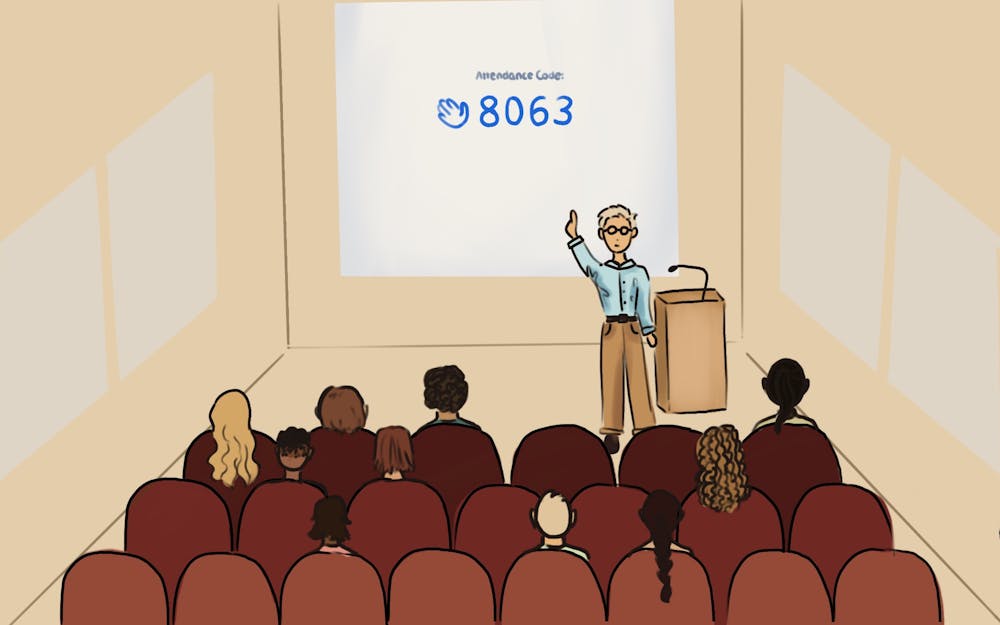During COVID-19, professors got used to staring at black screens dotted with colorful circles and asking questions to silent Zoom calls.
It was a common situation during the pandemic era of online lectures. In a 2022 survey by Times Higher Education, most teaching staff said both student attendance and engagement were poorer than in pre-COVID-19 pandemic years.
“It’s great to have that as a tool when you need it,” senior lecturer for the Media School Teresa White said. “But I don’t think anybody who teaches is going to say that that is equal to meeting with people in person.”
Another study found universities had experienced declining lecture attendance for years before the pandemic. With the increasing cost of college and living, the study shows that students have to work more to be able to afford tuition. The study found that Indiana students specifically would have to work 41 hours a week at minimum wage to be able to afford in-state tuition, up from the U.S. national average of 38.8 hours a week.
White has worked at IU since fall 2008 and has taught everything from upper-level reporting classes to introductory media classes. She said student attitudes toward attendance were different before the pandemic; it was a given that they had to show up and there were less cases of chronic absenteeism.
“There’s kind of a transactional attitude of like, ‘I just do my assignments, and I get the grade,’” White said. “The experience of being in a class is what really makes your education unique and more meaningful.”
She said online learning and personal devices may have hurt students’ attention spans. In addition, she said students could withdraw from a class right up until the week before finals during the pandemic.
White said she has used Top Hat, an online interaction software IU pays for, to track student attendance after students began returning to class after the pandemic.
“I primarily used it in large classes, because there really is no way to get a good idea of who’s there,” White said. “I didn’t use it to try to enforce a certain attendance policy, I tried instead to use it to create good — encourage good — habits.”
Top Hat has a geolocation feature that flags students who enter the correct attendance code but are not in the classroom. It can cause issues for students who don’t have their location services turned on, even if they are present, White said.
She said she couldn’t determine if it was Top Hat that incentivized students to come to class or other factors like class time or the day.
“I felt like the students who cared, it probably made a difference,” White said. “Because they had the incentive to come besides just, ‘Oh, I’m going to better understand the material.’”
Sara Mata is a lecturer in the chemistry department and had been at IU for only one semester in fall 2019 before everyone was sent home after spring break in 2020. She said she didn’t take attendance the first semester she was at IU, but after the pandemic, she began noticing poor turnout.
“It was very bad, and now it’s getting better, but to push the students to come to class, I had attendance,” Mata said.
Mata teaches a four-hour-long organic chemistry lab, as well as a few introductory courses. She started calculating attendance as up to 5% of a student's grade. She said it was a way to push students who are falling behind to feel like they could benefit simply by showing up.
She said oftentimes students would want extra credit at the end of the semester after not attending class, but she couldn’t afford another person or an assistant instructor to take on the extra, last-minute grading.
Mata said she was going back to not keeping track of attendance this semester for her smaller classes, as it often took up class time to wait for students to submit attendance responses.
“Instead of just giving them attendance, I just value their participation,” Mata said. “Because they could be in the classroom without really paying attention on the topic.”
She makes the questions through Top Hat, which can also be used for quizzes or surveys, and hasn’t yet run into any issues from students about the new format.
Mata said the silver lining to the pandemic was that teachers have become a lot more flexible regarding student time off for illness.
“I also had to be open to students missing more, because they could be sick, right?” Mata said. “I think that we became more conscious about, like, students can actually get a problem. They can get into a car accident. They can, you know, have problems in their lives, or just, like, plain sick.”
She said she thought attendance seems to finally be recovering from the earlier semesters of the pandemic, though it is difficult to track since attendance policies vary from professor to professor.
White said she believed in the value of face-to-face interaction and the experience of being in class, learning the material and asking questions.
“Let’s learn, let’s relearn, that joy of being with other people and the spontaneity of it,” White said. “Like eye contact and engaging with people and laughing together and working on something together. I guess I really value that.”



